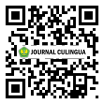INDONESIAN STUDENTS’ EXPERIENCE IN ONLINE LEARNING PROCESS AND INTERACTION DURING COVID-19
DOI:
https://doi.org/10.37301/culingua.v2i2.27Keywords:
Students’ Experience, Online Learning Process, InteractionAbstract
Since the beginning of 2020, Covid-19 has changed the face of global education. Online learning becomes the only feasible solution, albeit with the emergency nature in this crisis condition. Specifically in Indonesia, many elementary and middle school students struggle to cope with it and feel frustrated (Megawanti, Megawati, & Nurkhafifah, 2020). This paper observes such a phenomenon as this in Charis High School in Malang, Indonesia. It aims to identify students’ perceptions regarding the online learning process, as well as their perceptions regarding their interaction with the teacher and their peers. A 4-scale Likert-like questionnaire was distributed to 175 students of Charis High School. As many as 127 students responded. Overall, they did not have any problem with gadgets and internet connection. In general, the respondents had a good experience during their online learning period. They knew whether their study time is sufficient, and when they feel the need to, they did independent study outside of school period. This is even though, like many other students, some of them might get distracted during the study. They could conduct their learning smoothly from their home and their gadgets, although the internet connection might be an occasional hindrance. The students also enjoyed various learning methods and media provided by the teacher, while still wishing for other possible alternatives. Communication-wise, they had no problem while still missing having direct face-to-face communication again, especially with their peers.
References
Adnan, M. & Anwar, K. (2020). Online learning amid the COVID-19 pandemic: Students perspectives. Journal of Pedagogical Sociology and Psychology, 1(2), 45–51. https://doi.org/10.33902/jpsp.2020261309
Ally, M. (2008). Foundations of Educational Theory for Online Learning: Theory and Practice of Online Learning. Athabasca: AU Press
Angdhiri, R. P. (2020). Challenges of home learning during a pandemic through the eyes of a student. The Jakarta Post: Lifestyle. https://www.thejakartapost.com/life/2020/04/11/ challenges-of-home-learning-during-a-pandemic-through-the-eyes-of-a-student.html
AsiaQuest Indonesia. (2020). 5 Countries with Fastest Internet Connection. AsiaQuest Indonesia. https://aqi.co.id/en/news/negara-dengan-akses-internet-tercepat
Boettcher, J.V. & Conrad, R.M. (2010). E-coaching success tips. Retrieved on June, 2, 2012
Boston Public Library. (2021). Anna Eliot Ticknor and her society to encourage studies at home. The History List. https://www.thehistorylist.com/events/anna-eliot-ticknor-and-her-society-to-encourage-studies-at-home-boston-massachusetts
Costley, J. & Lange, C. (2018). The moderating effects of group work on the relationship between motivation and cognitive load. International Review of Research in Open and Distance Learning, 19(1), 68–90. https://doi.org/10.19173/irrodl.v19i1.3325
Charis National Academy. (n.d.). About us. https://charis.sch.id/about-us/introduction-to-charis
Creswell, J. W. (2012). Educational research: Planning, conducting, and evaluating quantitative and qualitative research (4th ed.). Boston: Pearson
Creswell, J. W. (2013). Qualitative inquiry & research design: Choosing among five approaches (3rd ed.). Thousand Oaks: SAGE Publications
Estelami, H. (2012). An exploratory study of the drivers of student satisfaction and learning experience in hybrid-online and purely online marketing courses. Marketing Education Review, 22(2), 143–156. https://doi.org/10.2753/mer1052-8008220204
Falloon, G. (2011). Exploring the virtual classroom: What students need to know (and teachers should consider). Journal of Research on Technology in Education, 7(4), 439–451.
Gudea, S. W. (2008). Perspectives on online teaching. Expectations and demands in online teaching: Practical experiences (pp. 1–26). IGI Global. https://doi.org/10.4018/9781599047478.ch001
Hodges, C., Moore, S., Lockee, B., Trust, T., & Bond, A. (2020). The difference between emergency remote teaching and online learning. Educause review. March 27, 2020. https://er.educause.edu/articles/2020/3/the-difference-between-emergency-remote-teaching-and-online-learning
Hussein, E., Daoud, S., Alrabaiah, H., & Badawi, R. (2020). Exploring undergraduate students’ attitudes towards emergency online learning during COVID-19: A case from the UAE. Children and youth services review, 119 (December). https://doi.org/10.1016/j.childyouth.2020.105699
Ko, S., & Rossen, S. (2010). Teaching online: a practical guide (eds.). New York: Taylor and Francis
Krishnapatria, K. (2020). From ‘lockdown’ to letdown: Students’ perception of e-learning amid the COVID-19 outbreak. ELT in Focus, 3(1), 1–8. https://doi.org/10.35706/eltinfc.v3i1.3694
Lewis, A. D., Huebner, E. S., Malone, P. S., & Valois, R. F. (2011). Life satisfaction and student engagement in adolescents. Journal of Youth and Adolescence, 40(3), 249–262. https://doi.org/10.1007/s10964-010-9517-6
Li, C. (2016). A survey on Chinese students’ online English language learning experience through synchronous web conferencing classrooms. In S. Papadima-Sophocleous, L. Bradley & S. Thouësny (Eds), CALL communities and culture – short papers from EUROCALL 2016 (pp. 265-270). Research-publishing.net. https://doi.org/10.14705/rpnet.2016.eurocall2016.573
Manfuso, L.G. (2020). From emergency remote teaching to rigorous online learning. EdTech magazine. https://edtechmagazine.com/higher/article/2020/05/emergency-remote-teaching-rigorous-online-learning-perfcon
Mayer, R.E. (2019). Thirty years of research on online learning. Applied cognitive psychology: Special issue, 33(2), 152--159, https://doi.org/10.1002/acp.3482
Megawanti, P., Megawati, E., & Nurkhafifah, S. (2020). Persepsi peserta didik terhadap PJJ pada masa pandemi COVID-19. Jurnal ilmiah pendidikan, 7(2), 75–82.
Nambiar, D. (2020). The impact of online learning during COVID-19: Students’ and teachers’ perspective. The international journal of Indian psychology, 8(2), 783–793. https://doi.org/10.25215/0802.094
OnlineSchools.org. (2021). The history of online schooling. Visual academy. https://www.onlineschools.org/visual-academy/the-history-of-online-schooling/
Ovilia, R. & Asfina, R. (2017). 21st Century Learning: Is ICT Really Integrated In EFL Classroom or Merely Segregated Outside The Classroom?. EnJourMe (English Journal of Merdeka) : Culture, Language, and Teaching of English, 2(1), 1–17. 2. 10.26905/enjourme.v2i1.527.
Paechter, M., & Maier, B. (2010). Online or face-to-face? Students’ experiences and preferences in e-learning. Internet and higher education, 13(4), 292–297. https://doi.org/10.1016/j.iheduc.2010.09.004
Perveen, A. (2016). Synchronous and asynchronous e-language learning: A case study of virtual university of Pakistan. Open praxis, 8(1), 21–39. https://doi.org/10.5944/openpraxis.8.1.212
Rahiem, M.D.H. (2020). The emergency remote learning experience of university students in Indonesia amidst the COVID-19 crisis. International journal of learning, teaching and educational research, 19(6), 1–26, June 2020. https://doi.org/10.26803/ijlter.19.6.1
Salmon, G. (2013). E-tivities: The key to active online learning. Abingdon: Routledge.
UNICEF. (2020). COVID-19?: UNICEF warns of continued damage to learning and well-being as number of children affected by school closures soars again. Reliefweb.int. https://reliefweb.int/report/world/covid-19-unicef-warns-continued-damage-learning-and-well-being-number-children-affected
University of the People. (n.d.). Emergency remote teaching vs. online learning: A comparison. Blog: Is UoPeople worth it. https://www.uopeople.edu/blog/emergency-remote-teaching-vs-online-learning/
Downloads
Published
Issue
Section
License
Copyright (c) 2021 Niken Paramita, Bagio Tjahjadi

This work is licensed under a Creative Commons Attribution 4.0 International License.









